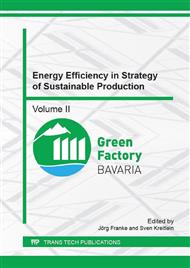p.57
p.64
p.73
p.82
p.91
p.99
p.109
p.117
p.123
A Lean-Based Key Performance Analysis for a Resource Efficient Soldering Oven in Electronics Production
Abstract:
The reflow soldering in electronics production is identified as an energy-intensive process that requires further resource efficiency optimization. A lean-based analysis of the resource consumption in production at different factory levels illustrates the minimum resource consumption and saving potentials in the soldering process. The four levels namely factory, machine, process, and product represent the hierarchical structure within the production facility and establish a transparent overview model. The value-added energy investigation is conducted at all levels, and additionally the exergy method is used in the product level to investigate the material transformation efficiency and the minimum resource consumption in the model. The results in different levels illustrate the energy efficiency of each level, the energy wastage, and the potential for further optimization.
Info:
Periodical:
Pages:
91-98
Citation:
Online since:
November 2016
Authors:
Price:
Сopyright:
© 2017 Trans Tech Publications Ltd. All Rights Reserved
Share:
Citation:


